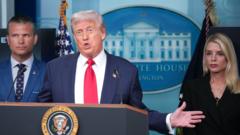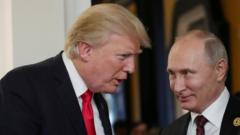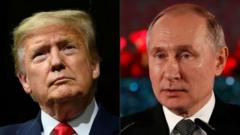As President Trump asserts a crime emergency in Washington DC, findings reveal a decline in violent crime and homicide rates, raising questions about the accuracy of presented claims.**
Analyzing Crime Trends in Washington DC: Is It Really 'Out of Control'?**

Analyzing Crime Trends in Washington DC: Is It Really 'Out of Control'?**
A deep dive into the contrasting claims regarding crime rates in the nation's capital amidst political rhetoric.**
Amid declarations from President Donald Trump regarding a crime emergency in Washington DC, he proclaimed his intention to deploy National Guard troops and take charge of the local police to combat what he described as rampant crime. In a dramatic press briefing, he labeled a day "Liberation Day," vowing to liberate the capital from escalating violence and chaos.
However, contrasting this alarming narrative, Mayor Muriel Bowser reported a significant drop in crime, emphasizing that violent crime rates in the city have plummeted to a 30-year low. BBC Verify's investigation scrutinizes the latest statistics, debating whether crime in DC is truly spiraling out of control, as Trump asserts.
The president’s executive order portrays Washington as suffering from rising violence, and he repeatedly insisted that crime is out of control. Nevertheless, data from the Metropolitan Police Department (MPDC) suggests otherwise, indicating that violent crime peaked in 2023 and has subsequently declined significantly. Preliminary figures for 2025 highlight a remarkable 26% decrease in violent crime compared to the same point in 2024, with robbery incidents also falling by 28%.
While Trump and the DC Police Union have challenged the integrity of the MPDC's reported figures, the discrepancies between MPDC and FBI statistics underscore a complex scenario. The MPDC's data reflects a substantial 35% drop in 2024, contrasting with the FBI's reported 9% decline, yet both sources agree on a downward trend in crime.
Adam Gelb, CEO of the Council on Criminal Justice, confirms that there is an evident and substantial decline in violence since mid-2023. He notes, however, that various factors, such as reporting periods and specific crime types, affect the presentation of these statistics.
Trump's assertion regarding record-high murder rates in 2023 also warrants scrutiny. Although data indicates a spike in homicides that year—approximately 40 per 100,000 residents—the figures were lower than those seen in prior decades. Reports from MPDC indicate a reduction in the homicide rate for 2024, and the current year has seen a further 12% decrease from last year's numbers.
Carjackings, another area of concern highlighted by Trump, are reported to have decreased in 2025 compared to the previous year, despite his claims of a tripling in such incidents over five years. The MPDC has documented 189 carjackings this year, down from 300 during the same timeframe last year.
As comparisons with other major cities reveal, while Washington DC's violence remains higher than the average across many cities, the significant downward trajectory aligns with national trends of decreasing crime rates. An analysis of data from 30 large US cities shows that DC's homicide rate fell by 19% in the first half of 2025 compared to a 17% drop in other urban areas.
Ultimately, the dynamic landscape of crime statistics presents a complex picture, suggesting a marked decline in certain violent crimes within Washington DC, which contradicts the dire narrative spun by some political figures. The ongoing dialogue about safety in the nation's capital continues to evolve as data emerges from multiple sources.



















